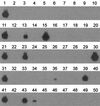Detection of influenza A viruses from different species by PCR amplification of conserved sequences in the matrix gene
- PMID: 11060074
- PMCID: PMC87547
- DOI: 10.1128/JCM.38.11.4096-4101.2000
Detection of influenza A viruses from different species by PCR amplification of conserved sequences in the matrix gene
Abstract
The recently raised awareness of the threat of a new influenza pandemic has stimulated interest in the detection of influenza A viruses in human as well as animal secretions. Virus isolation alone is unsatisfactory for this purpose because of its inherent limited sensitivity and the lack of host cells that are universally permissive to all influenza A viruses. Previously described PCR methods are more sensitive but are targeted predominantly at virus strains currently circulating in humans, since the sequences of the primer sets display considerable numbers of mismatches to the sequences of animal influenza A viruses. Therefore, a new set of primers, based on highly conserved regions of the matrix gene, was designed for single-tube reverse transcription-PCR for the detection of influenza A viruses from multiple species. This PCR proved to be fully reactive with a panel of 25 genetically diverse virus isolates that were obtained from birds, humans, pigs, horses, and seals and that included all known subtypes of influenza A virus. It was not reactive with the 11 other RNA viruses tested. Comparative tests with throat swab samples from humans and fecal and cloacal swab samples from birds confirmed that the new PCR is faster and up to 100-fold more sensitive than classical virus isolation procedures.
Figures






Comment in
-
False-positive results obtained by following a commonly used reverse transcription-PCR protocol for detection of influenza A virus.J Clin Microbiol. 2006 Oct;44(10):3845. doi: 10.1128/JCM.00916-06. J Clin Microbiol. 2006. PMID: 17021126 Free PMC article. No abstract available.
References
-
- Brown T. Analysis of DNA sequences by blotting and hybridization. In: Ausubel F M, Brent R, Kingston R E, Moore D D, Seidman J G, Smith J A, Struhl K, editors. Current protocols in molecular biology, suppl. 45. New York, N.Y: John Wiley & Sons, Inc.; 2000. pp. 2.9.1–2.9.15.
-
- Claas E C, Osterhaus A D. New clues to the emergence of flu pandemics. Nat Med. 1998;4:1122–1123. - PubMed
-
- Claas E C, Osterhaus A D, van Beek R, De Jong J C, Rimmelzwaan G F, Senne D A, Krauss S, Shortridge K F, Webster R G. Human influenza A H5N1 virus related to a highly pathogenic avian influenza virus. Lancet. 1998;351:472–477. - PubMed
Publication types
MeSH terms
Substances
LinkOut - more resources
Full Text Sources
Other Literature Sources
Medical

